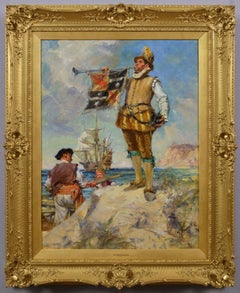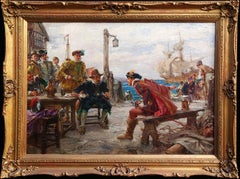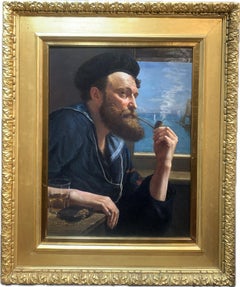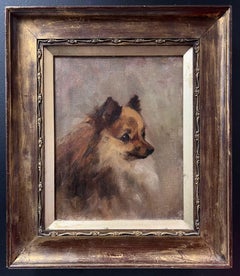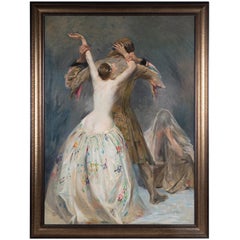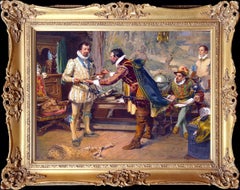Arthur David McCormick
to
2
1
Overall Width
to
Overall Height
to
1
2
2
1
3
2
2
1
1
1
3
3
3
3
3
9,514
2,710
1,375
1,361
3
3
Artist: Arthur David McCormick
Historical genre oil painting of a royal messenger
By Arthur David McCormick
Located in Nr Broadway, Worcestershire
Arthur David Mccormick
Irish/British, (1860-1943)
The Royal Fanfare
Oil on canvas, signed
Image size: 23.5 inches x 17.5 inches
Size including frame: 31.5 inches x 25.5 inches
Provenance: Frost & Reed
A wonderful historical painting of a trumpeter signalling the arrival of the Royal Ship by Arthur David Mccormick. The Herald, dressed in yellow livery plays a fanfare as the others prepare for the arrival of the Royal boat.
Arthur David Mccormick was a painter of historical, naval, and genre scenes who was born in Coleraine, Ulster in Northern Ireland on 14 October, 1860. After attending his local school, he studied at the Government School of Design in Belfast. He then moved to London where he enrolled at the Royal College of Art in 1883. To support his studies he also contributed drawings and designs to the English Illustrated Magazine and Illustrated London News.
McCormick made his debut at the Royal Academy in 1889 continuing to exhibit there throughout his life. He exhibited at the Royal Society of British Artists from 1890, becoming a member in 1897 and at the Royal Institute of Oil Painters, Royal Institute of Painters in Watercolour and the Alpine Club Gallery. As well as being a yachtsman he also took an interest in mountaineering and on 5 February 1892 joined Sir Martin Conway’s expedition to the Karakoram Himalayas as their artist. He produced more than 300 illustrations, mainly watercolour paintings which appeared in Conway's 1894 book ‘Climbing and exploration in the Karakoram Himalayas’. He later published his own book ‘An artist in the Himalayas’ using his pencil sketches from the expedition.
He married Helen MacAlpine-Woods at Strean Church, Newtonwards, Ireland on 25 September, 1894. The couple lived at 58 Queens Road, St John’s Wood where their only daughter Helen Gladys was born in 1895. During the same year, he travelled with Clinton T. Dent’s on his expedition to the Caucasus Mountains, producing a number of sketches and drawings. He was also made a fellow of the Royal Geographical Society in 1895 in recognition of his work.
After the death of his wife in 1899, he remained at Queens Road from where he continued to work and exhibit, employing a governess to help with his daughter. When the Ulster Arts Club was formed in 1902 he was among its first honorary members. In 1905, he was made a member of the Royal Institute of Oil Painters and in 1906 became a member of the Royal Institute of Painters in Watercolours. On 7 May, 1906 he married Helen (Nellie) Elizabeth K Laker, his daughter’s governess. In addition to painting he also produced illustrations for many books mostly related to travel and adventure. He was employed by John Player & Son in 1927 to paint the sailor's head and shoulders for their cigarette packets as well as producing a number of oil paintings which were used as promotional posters.
Around 1934 he moved to 53 Colet Gardens, Hammersmith, where he spent the rest of his life. He died in London, aged 83, on 12 March, 1943. Examples of his work can be found at the Alpine Club Collection, Coleraine Museum, Grundy Art Gallery, Imperial War Museum, National Museum of Wales, National Museum of the Royal Navy Portsmouth, Newport Museum, The Box Plymouth and Williamson Art Gallery.
Presentation: The work is housed in its original gilt frame which is in excellent condition. The reverse bears a label for Frost & Reed and is dated 5 November 1936. Frost & Reed is a well known fine Art Gallery, frame makers and fine art publishers founded in Bristol in 1808 by William Hill. The business was bought by John Frost in 1859 who ran it until his death in 1875. His nephew Walter Frost took over the business and in 1881 brought in William Reed...
Category
Early 20th Century Arthur David McCormick
Materials
Canvas, Oil
Drake's Tales of Treachery
By Arthur David McCormick
Located in Belgravia, London, London
Oil on canvas
Canvas size: 20 x 30 inches
Framed size: 28 x 36 inches
Signed lower right
Category
19th Century Arthur David McCormick
Materials
Canvas, Oil
Sailor Smoking a Pipe
By Arthur David McCormick
Located in London, GB
Sailor Smoking a Pipe
Arthur David McCormick
Oil on canvas
Image size: 19 x 25 1/2 inches (48 x 65 cm)
Contemporary frame
Arthur David McCormick (1860–1943) was a notable British illustrator and painter, renowned for his landscapes, historical scenes, naval subjects, and genre scenes. Born in Coleraine, County Londonderry, he pursued his education at the Royal College of Art in London from 1883 to 1886.
McCormick’s career was marked by his contributions to various illustrated magazines, including the English Illustrated Magazine and the Illustrated London News. He participated in significant expeditions, such as Sir Martin Conway’s journey to the Karakoram Himalayas in 1892 and Clinton T. Dent’s expedition to the Caucasus Mountains in 1895. His illustrations from these travels were featured in Conway’s book “Climbing and Exploration in the Karakoram-Himalayas” (1894) and his own publication “An Artist in the Himalayas” (1895).
Throughout his career, McCormick illustrated nearly thirty books, focusing on travel and adventure themes. Some of his notable works include illustrations for Edgar Allan Poe’s “Tales of Mystery and Imagination” (1905) and Henry Newbolt’s “Drake’s Drum and Other Songs of the Sea” (1914). He was also a regular exhibitor at the Royal Academy from 1889 to 1938.
Navy Cut Sailor Work...
Category
20th Century English School Arthur David McCormick
Materials
Canvas, Oil
Related Items
Antique English Oil Painting Portrait of Pomeranian Dog 19th Century framed
Located in Cirencester, Gloucestershire
Portrait of a Pomeranian Dog
English artist, late 19th century
oil on canvas, framed
Framed: 14.5 x 12.5 inches
Canvas: 10 x 8 inches
Provenance: Private collection, Surrey, England
...
Category
Late 19th Century English School Arthur David McCormick
Materials
Oil, Canvas
$1,549 Sale Price
30% Off
H 14.5 in W 12.5 in
Oil on Canvas Depicting William Shakespeare's Characters "Othello & Desdemona"
By Hamilton Hamilton
Located in LA, CA
Hamilton Hamilton (American, 1847-1928) A large and impressive oil on canvas "Othello and Desdemona" after the William Shakespeare's play "Othello", depicting a young Desdemona pleading with an enraged Othello, and perhaps Iago is the seated figure, within a giltwood craquelure finished frame. Signed (l/r): H. Hamilton, 1921 .
Canvas Height: 67 inches (170.2 cm)
Canvas Width: 48 inches (121.9 cm)
Frame Height: 75 inches (190.5 cm)
Frame Width: 57 inches (144.8 cm)
Frame Depth: 2 inches (5.1 cm)
Hamilton Hamilton (1 April 1847 – 4 January 1928) was a painter and etcher, known mostly for his landscapes of the American West. Born in Oxford, England, he lived most of his life in the Eastern United States. He painted landscapes in New York, Connecticut, the American West, England, and France. He also painted portraits and drew illustrations.
Artistic career
Hamilton Hamilton was born in Oxford, England, on 1 April 1847. While young, he was a protégé of John Ruskin. In 1872, he began his mostly self-taught career as a portrait artist in Buffalo, New York. He created 47 landscape paintings during an 1873 expedition to Colorado which were chosen to be part of the 1876 Centennial Exposition in Philadelphia. He spent 1878 and 1879 painting in Pont-Aven, Brittany, alongside Barbizon School painters.
He moved to New York City in 1881 and shortly after began to practice genre painting and etching.[6] He became an associate member of the National Academy of Design in 1886 and a National Academician in 1889. Until the end of the century, he and his family resided alternately in upstate New York, Long Island, Colorado, and England.[6] In 1907 and 1908, Hamilton spent two years painting landscapes in Southern California. In 1912 he and his family permanently moved to Norwalk, Connecticut. There he became involved with the Silvermine group of artists led by Solon Borglum...
Category
Early 20th Century American Impressionist Arthur David McCormick
Materials
Canvas, Wood, Oil
$34,500
H 75 in W 57 in D 2 in
Fine Large 1800's English Oil Country Gentleman in Parkland before Stately Home
Located in Cirencester, Gloucestershire
The English Gentleman and his Country House
English artist, circa 1800-1820 period
Fine Georgian period portrait of a young English gentleman, seated with distant view of his country...
Category
Early 19th Century English School Arthur David McCormick
Materials
Oil, Canvas
$2,676 Sale Price
30% Off
H 36 in W 28 in
1830's British Oil Painting Large Portrait of a Distinguished Gentleman
Located in Cirencester, Gloucestershire
Portrait of an English Gentleman
English School, circa 1830's period
oil on canvas, unframed
Canvas: 30 x 24.5 inches
Provenance: Private collection, UK
Condition: relined canvas, ov...
Category
Early 19th Century English School Arthur David McCormick
Materials
Oil, Canvas
$1,549 Sale Price
30% Off
H 30 in W 24.5 in
A Very Fine Italian Oil on Canvas Titled "The Solo Violinist or Violin Teacher "
Located in LA, CA
A very fine Italian oil on canvas titled "The Solo Violinist" by Luigi Da Rios (Italian, 1844-1892), depicting an interior 18th century room scene of a single violinist player; withi...
Category
Late 19th Century Academic Arthur David McCormick
Materials
Gesso, Canvas, Wood, Oil
$19,850
H 25.88 in W 20.25 in D 3.5 in
Mid-18th-Century English School, Portrait Of A Girl With A Posy
Located in Cheltenham, GB
This exceedingly charming mid-18th-century English oil painting depicts a girl wearing a red gown with a train over a white petticoat. She’s holding a posy or nosegay.
Evidently once commissioned for an English country house, the identity of this young lady remains a mystery. Her gown appears to be inspired by the popular ‘robe à la française...
Category
1740s English School Arthur David McCormick
Materials
Oil, Canvas
Portrait of WW11 British Army Officer Soldier Antique English Oil Painting
Located in Cirencester, Gloucestershire
The Army Officer *see notes below
by Kathleen Emily Temple-Bird (British 1879 - 1962)
oil painting on canvas , unframed
canvas: 24 x 18 inches
condition: very good, minor surface scu...
Category
1930s English School Arthur David McCormick
Materials
Oil, Canvas
$1,164 Sale Price
30% Off
H 24 in W 18 in
Antique Late 19th Century English Oil on Canvas Painting Female Portrait 1900
Located in Portland, OR
Antique English oil on canvas portrait painting, circa 1900. A very handsome Impressionist portrait of a youthful lady in Edwardian dress. Oil on canvas, signed to the upper left "F ...
Category
Early 1900s English School Arthur David McCormick
Materials
Canvas, Oil
$1,900
H 33.25 in W 29.5 in D 2 in
19th century portrait of a spaniel dog in a landscape, a country house beyond
By Charles Bilger Spalding
Located in Bath, Somerset
A 19th century black and white spaniel standing in a landscape, with a country house in the distance. Signed C B Spalding, lower right.
Oil on canvas in a giltwood frame.
Charles B...
Category
19th Century English School Arthur David McCormick
Materials
Canvas, Oil
$3,756 Sale Price
20% Off
H 16.34 in W 22.45 in
English 18th century portrait of a water spaniel dog standing in a landscape
By George Stubbs
Located in Bath, Somerset
Circle of George Stubbs (1724-1806). English 18th century portrait of a water spaniel standing in a wooded landscape.
This charming painting is a wonderful example of the style of English dog painting made popular by artists such as George Stubbs and other sporting artists working in England in the 18th century who painted the dogs and horses of the aristocracy and wealthier classes. It follows in the ancient tradition of celebrating and commemorating our faithful canine companions through portraiture.
Oil on canvas in a giltwood frame
Provenance: Private collection, Somerset
George Stubbs (1724-1806) was classified in his lifetime as a sporting painter, and as such was excluded from full membership of the Royal Academy. He is best remembered for his paintings of horses and his conversation pieces. Having studied anatomy, Stubbs's pictures of horses are among the most accurate ever painted.
Stubbs was born in Liverpool, the son of a leather worker...
Category
18th Century English School Arthur David McCormick
Materials
Canvas, Oil
$15,560 Sale Price
20% Off
H 27.56 in W 31.11 in
Frederick George Cotman Impressionist oil painting Suffolk river landscape
By Frederick George Cotman
Located in Harkstead, GB
An impressive, panoramic view of the River Stour looking towards Harwich and Felixstowe in Suffolk. It is very much a snapshot of times gone by with the hay barge loaded with hay.
F...
Category
19th Century Impressionist Arthur David McCormick
Materials
Oil, Canvas
$1,737 Sale Price
30% Off
H 21.5 in W 30 in D 2 in
Hotel Night Lobby. Large Mid-Century American Oil Painting.
Located in Marco Island, FL
A long and quiet night in the hotel lobby is depicted by Clyde Singer in this moody and still painting. Entitled Hotel Night Lobby (1947), Singer paints a moment of solitude during ...
Category
1940s American Realist Arthur David McCormick
Materials
Oil, Canvas
Previously Available Items
Treasures From A Far
By Arthur David McCormick
Located in Belgravia, London, London
Oil on canvas
Canvas size: 21 x 28 inches
Framed size: 27.25 x 35 inches
Signed lower right
Category
19th Century Arthur David McCormick
Materials
Canvas, Oil
Arthur David Mccormick art for sale on 1stDibs.
Find a wide variety of authentic Arthur David McCormick available for sale on 1stDibs. You can also browse by medium to find art by Arthur David McCormick in canvas, fabric, oil paint and more. Not every interior allows for large Arthur David McCormick, so small editions measuring 26 inches across are available. Customers who are interested in this artist might also find the work of Benjamin Williams Leader, Frank Moss Bennett, and Adolphus Knell. Arthur David McCormick prices can differ depending upon medium, time period and other attributes. On 1stDibs, the price for these items starts at $5,861 and tops out at $5,861, while the average work can sell for $5,861.
